Literature is power. Regardless of genre. In fact, it is so powerful that throughout history, literature has invoked fear to the point of banning, burning, censorship, and more. Why is it so powerful? It represents. People, history, ideas, facts, theories, perspectives, realities. It challenges. Literature provides information that may align with our belief systems or contest them. It can offer differing and multiple perspectives, provoking questions and leading to searches for truth or deeper understanding. It transforms. Literature can generate a connection with and empathy for characters and people unlike ourselves, showing us that our reality is not everyone’s reality. And in doing so, it can change us dramatically from the inside out.
Literature provides an experience. And so, I challenge schools to extend Black History Month and provide students with the opportunity to be represented, challenged, and transformed through varied, rich literature representing Black individuals, narratives, families, communities, and history all year long.
But before diving into this, let’s take a look at why Black History Month is celebrated and the original vision.
The History of Black History Month
How Did Black History Month Start?
According to the Association for the Study of African American Life and History (ASALH), the roots of Black History Month started way back in 1915 with a man named Carter G. Woodson, Ph.D. Along with other African American exhibitors, Dr. Woodson participated in a three-week celebration in Chicago, Illinois, celebrating the fiftieth anniversary of the emancipation proclamation. The celebration included exhibits spotlighting the progress made by African Americans over the past 50 years. Dr. Woodson’s exhibit featured Black history. This experience led him to form an organization, the Association for the Study of Negro Life and History (ASNLH), now the ASALH, along with A.L. Jackson and three others, and to establish The Journal of Negro History in 1916. In 1924, in collaboration with his fraternity brothers in Omega Psi Ohi, the Negro Achievement Week was created, with significant outreach through the journal. Dr. Woodson desired greater impact, and in February of 1926, he publicized Negro History Week through a press release.
Why Is Black History Month in February?
Dr. Woodson chose February primarily due to tradition within the Black community since Abraham Lincoln’s and Frederick Douglass’s birthdays were both widely celebrated in the community during this month. He wanted to build Negro History Week into pre-existing celebrations of Black history. But his underlying desire was to transform celebrations into a celebration of African Americans because he believed that the people created history, not just “great men.”
What Was the Response?
The response was overwhelming and led to the vast expansion of the ASNLH across the United States. However, Dr. Woodson fought against any commercialization or trivialization of Negro History Week since there were publications of non-scholarly works, “intellectual charlatans,” and those seeking to profit from public interest in Black history. And he pushed schools to use this week “to demonstrate what students learned all year.” The Black community slowly expanded the study of Black history in the 1940s by teaching it in schools. Freedom Schools in the south also incorporated it into the curriculum.
When Did Black History Month Celebrations Begin?
West Virginia celebrated Black History Month in February as early as the 1940s, and activist Frederick H. Hammaurabi began celebrating it in Chicago in the mid-1960s. By the late 1960s, college students led protests for the inclusion of Black Studies in universities, and there was an expansion of celebrations into the public. Additionally, there were calls for a month-long celebration by notable groups, universities, and communities.

When Was Black History Month Officially Recognized?
In 1976, the association started by Dr. Woodson replaced Negro history with Black history and moved from a week-long celebration to a month-long celebration. February 1976 was the first official Black History Month, proclaimed by President Gerald Ford, and every United States President has promoted the annual theme for Black History Month since the mid-1970s.
Literature for Black History Month
So in the spirit of Dr. Woodson’s vision for seeing the Black community, Black history, Black progress, and Black people celebrated throughout the year, I took to Twitter to ask educators, librarians, readers, and thought leaders for literature recommendations. I also perused some other great book lists to help with the compilation. Here are the results. Please note that books may be great for multiple grade levels. So explore! Don’t be afraid to take some pre-kindergarten picture books and put them in your second-grade classroom library or put books from early elementary in your fifth-grade classroom, for example. And be sure to read the books in advance. Mix it up and fill your school or classroom with a diverse array of powerful literature.
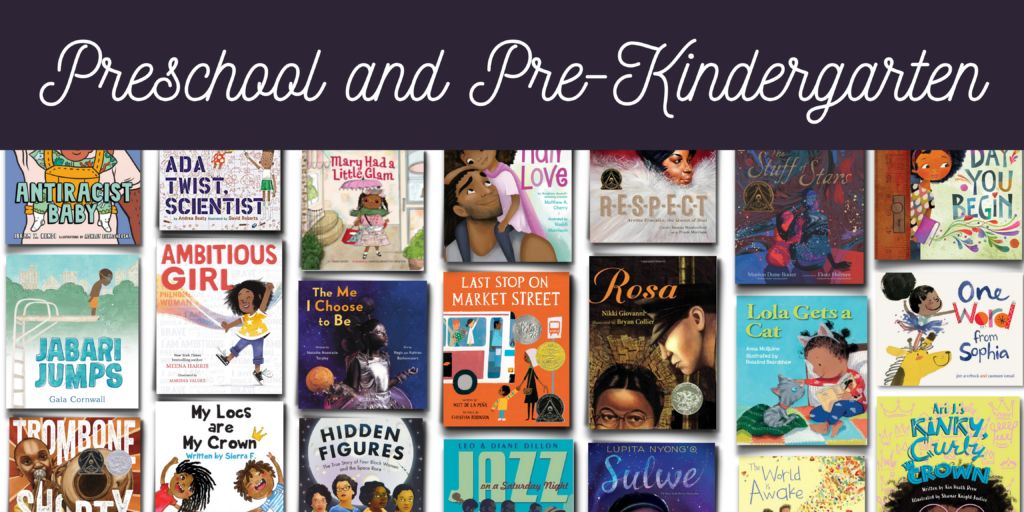
Mary Had a Little Glam 0+
Ari J.’s Kinky Curly Crown 2+
Antiracist Baby 2+
Homemade Love 2+
Lola Gets a Cat 2+
Mindful Mr. Sloth 2+
My Locs Are My Crown 2+
Please, Baby, Please 2+
Ada Twist, Scientist 3+
Hair Love 3+
Last Stop on Market Street 3+
The King of Kindergarten 3+
The World Is Awake 3+
All Are Welcome 4+
Ambitious Girl 4+
The Day You Begin 4+
Hidden Figures: The True Story of Four Black Women and the Space Race 4+
I Can Be Anything, Don’t Tell Me I Can’t! 4+
Jabari Jumps 4+
Jazz on a Saturday Night 4+
Just Ask! Be Different, Be Brave, Be You 4+
The Me I Choose To Be 4+
One Word from Sophia 4+
Rosa 4+
R-E-S-P-E-C-T: Aretha Franklin, The Queen of Soul 4+
Sulwe 4+
Trombone Shorty 4+
The Stuff of Stars 4+
What Is Given from the Heart 4+
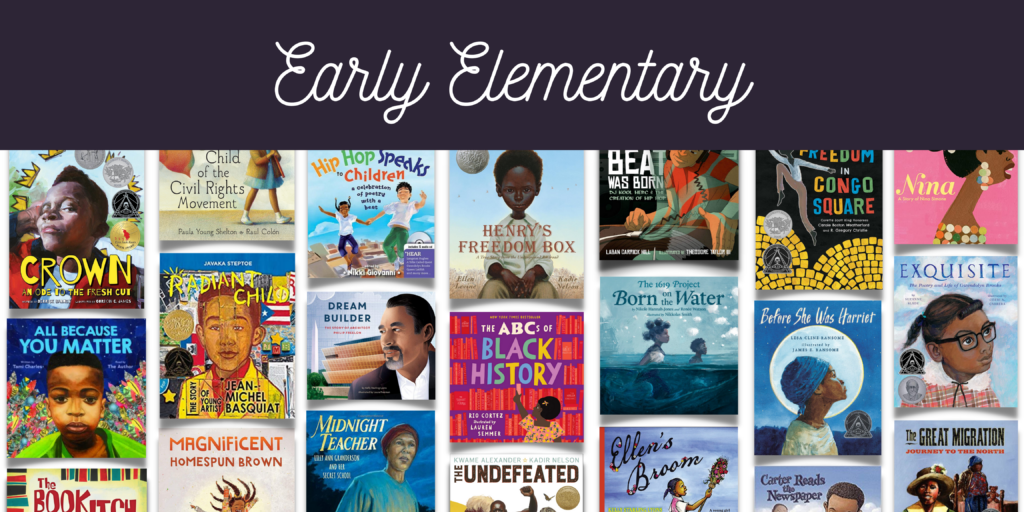
The ABCs of Black History 5+
All Because You Matter 5+
Child of the Civil Rights Movement 5+
Crown: An Ode to the Fresh Cut 5+
Dream Builder: The Story of Architect Philip Freelon 5+
Ellen’s Broom 5+
Freedom in Congo Square 5+
Henry’s Freedom Box 5+
Before She Was Harriet 6+
Carter Reads the Newspaper 6+
Exquisite: The Poetry and Life of Gwendolyn Brooks 6+
Freedom Over Me: Eleven Slaves, Their Lives and Dreams, Brought to Life 6+
The Great Migration: Journey to the North 6+
I Have A Dream 6+
It Jes’ Happened 6+
Keena Ford and the Second Grade Mix-Up 6+
Magnificent Homespun Brown: A Celebration 6+
Midnight Teacher: Lilly Ann Granderson and Her Secret School 6+
Nina: A Story of Nina Simone 6+
Pies from Nowhere 6+
The Undefeated 6+
When the Beat Was Born: DJ Kool Herc and the Creation of Hip Hop 6+
William Still and His Freedom Stories: The Father of the Underground Railroad 6+
The 1619 Project: Born on the Water 7+
The Book Itch: Freedom, Truth, and Harlem’s Greatest Bookstore 7+
Hip Hop Speaks to Children 7+
The People Remember 7+
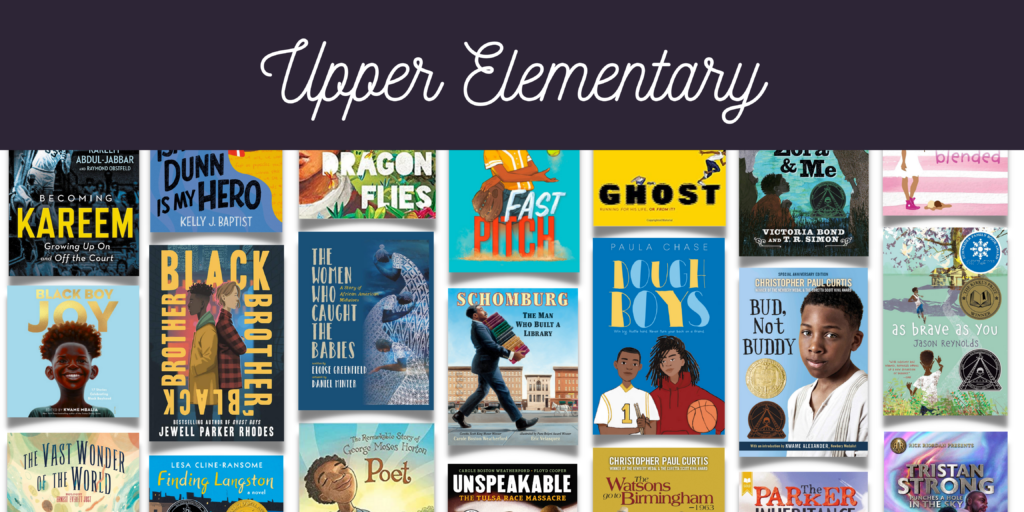
Black Boy Joy 8+
Black Brother, Black Brother 8+
Finding Langston 8+
Hidden Figures Young Reader’s Edition 8+
Poet: The Remarkable Story of George Moses Horton 8+
The Vast Wonder of the World: Biologist Ernest Everett Just 8+
The Women Who Caught the Babies 8+
Tristan Strong Series 8+
Schomburg: The Man Who Built a Library 8+
Unspeakable: The Tulsa Race Massacre 8+
Bud, Not Buddy 9+
Blended 8+
Fast Pitch 8+
New Kid, Book 1 8 +
The Parker Inheritance 8+
Dough Boys 8+
Unbound: A Novel in Verse 8+
We Are Family 8+
Clean Getaway 9+
The Crossover 9+
Heart and Soul: The Story of America and African Americans 9+
Stella by Starlight 9+
The Mighty Miss Malone 9+
As Brave As You 10+
Becoming Kareem: Growing Up On and Off the Court 10+
Betty Before X 10+
Brown Girl Dreaming 10+
Elijah of Buxton 10+
Ghost Boys 10+
Ghost: Track, Book 1 10+
Harbor Me 10+
Hidden Figures 10+
Isaiah Dunn Is My Hero 10+
Lifting As We Climb: Black Women’s Battle for the Ballot Box 10+
Look Both Ways: A Tale Told in Ten Blocks 10+
Tight 10+
Class Act New Kid, Book 2 10+
King and the Dragonflies 10+
The Last Day of Summer: Legendary Alston Boys, Book 1 10+
Ninth Ward 10+
The Lions of Little Rock 10+
The Watsons Go to Birmingham 10+
Zora and Me 10+
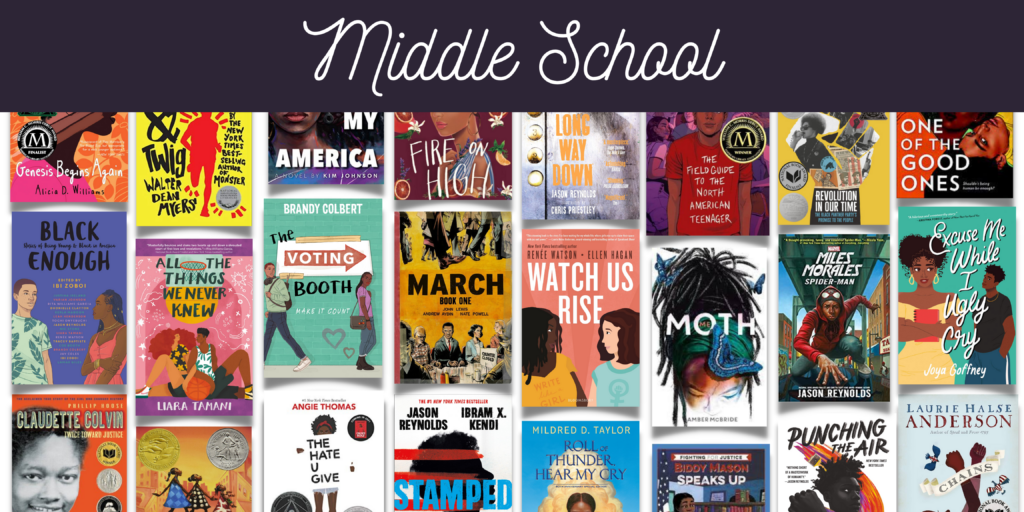
Biddy Mason Speaks Up 11+
Chains (The Seeds of America Trilogy) 11+
March Forward Girl: From Young Warrior to Little Rock Nine 11+
One Crazy Summer 11+
Roll of Thunder, Hear My Cry 11+
Genesis Begins Again 11+
Home Is Not a Country 12+
How I Discovered Poetry 12+
In The Shadow of Liberty: The Hidden History of Slavery, Four Presidents, and Five Black Lives 12+
Loving vs. Virginia: A Documentary Novel of the Landmark Civil Rights Case 12+
March: Book One (Trilogy) 12+
Miles Morales: Spider-Man 12+
This Is My America 12+
Revolution in Our Time: The Black Panther Party’s Promise to the People 12+
Stamped: Racism, Antiracism, and You 12+
The Voting Booth 12+
All the Right Stuff 13+
All the Things We Never Knew 13+
Black Enough: Stories of Being Young & Black in America 13+
Claudette Colvin: Twice Toward Justice 13+
Darius & Twig 13+
Dread Nation 13+
Excuse Me While I Ugly Cry 13+
If It Makes You Happy 13+
Long Way Down: The Graphic Nove 13+
Me (Moth) 13+
Monster 13+
With the Fire on High 13+
The Hate You Give 13+
The Boy in the Black Suit 13+
The Poet X 13+
One of the Good Ones 13+
Piecing Me Together 13+
Pride 13+
Punching the Air 13+
The Field Guide to the North American Teenager 13+
The Right Side of Wreckless 13+
The Skin I’m In 13+
Watch Us Rise 13+
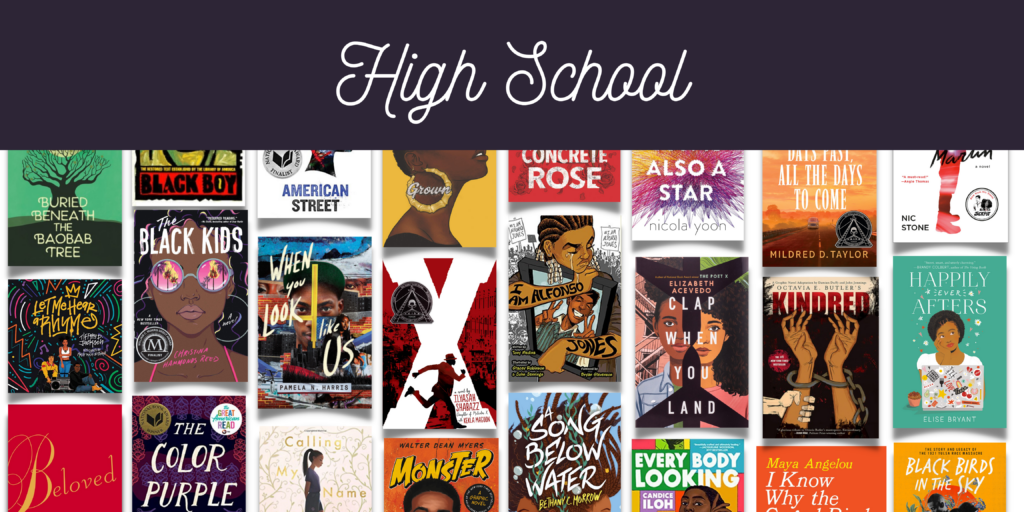
Black Boy 14+
Black Birds in the Sky 14+
Buried Beneath the Baobab Tree 14+
Calling My Name 14+
Clap When You Land 14+
Concrete Rose 14+
Dear Martin 14+
Every Body Looking 14+
A Song Below Water 14+
Happily Ever Afters 14+
I Am Alfonso Jones 14+
Let Me Hear A Rhyme 14+
Monday’s Not Coming 14+
Monster: A Graphic Novel 14+
I Know Why the Caged Bird Sings 14+
The Black Kids 14+
Kindred: A Graphic Novel Adaptation 14+
On the Come Up 14+
Their Eyes Were Watching God 14+
The Stars and the Blackness Between Them 14+
The Sun Is Also a Star 14+
Slay 14+
X: A Novel 14+
All the Days Past, All the Days to Come 15+
Beloved 15+
Not So Pure and Simple 15+
The Astonishing Life of Octavian Nothing 15+
The Color Purple 15+
The Underground Railroad 15+
Ace of Spades 16+
American Street 16+
Grown 16+
When You Look Like Us 16+
Additional Literature Resources
The Freedom Reads Book Club, through BreakFree Education, provides some fantastic and diverse novels for literature study each month. They also include free Teacher’s Companion Guides. This is an organization with a wonderful mission “to radically improve education in the juvenile and criminal justice systems by investing in the potential and dignity of all its students.” And everyone reading this article should head to their website when they finish!
San Jose Public Library published a great list of graphic novels featuring Black characters and narratives. I highly recommend taking a look and including these in your school or classroom library (if you’ve not already).
The Ethnic and Multicultural Information Exchange Round Table (EMIERT) has published lists of all recipients of the Coretta Scott King Book Awards from 1970 to the present. There are also free, published discussion guides for 2009-2021. We are talking about phenomenal literary works here.
Social Justice Books has some really incredible resources, reviews by theme, and articles available. There are a number of book lists published celebrating multiculturalism and social justice for all ages. They also have a Guide for Selecting Anti-Bias Children’s Books that offers strong guidance.
Marley Dias is the 16 year old author of Marley Dias Gets It Done: And So Can You!. She is also the founder of #1000BlackGirlBooks, which she started because she wanted to read more books with Black girls as main characters. She has now collected over 13,000 titles and offers 1,000 in her database, updated every three to six months. You can filter by author, title, and reading level to find some great books. What an amazing vision, and isn’t it great that she has taken action? I love this.
Louisiana Anti-Bias Education also has a great spreadsheet with literature broken down by grade-level band with notes. They also include a teacher resource tab with some excellent links to check out.
This list and the resources provided do not do justice to all the incredible Black and African American literature available. Give your students daily access to the power of this literature and let them experience it fully. Let’s embrace the realities of Black History and the Black and African American narrative and incorporate them all year long.
Want to look at more resources for Black History Month and beyond? Here are some additional TechNotes articles for you:
- MLK Jr. Digital Breakout (2022)
- Five Martin Luther King, Jr. Templates and Activities for the Classroom (2022)
- Black History Month Resources (2021)
- Today Is National Freedom Day (2021)
- Teaching and Celebrating Martin Luther King, Jr. Day (2021)
- Digital Resources for MLK Day (2020)
- Understanding This Moment through Civic Education
- Exploring Civil Rights History with Digital Resources
- Digital Resources to Celebrate and Teach Juneteenth
- Exploring Local History During Remote Learning



2 comments
I sure wish you would work this hard for the Native American/First Nation People, who are MUCH more under-represented, and much more deserving of more thought. This seems to me that you are just jumping on the popular, flavor-of-the-month movement, and it seems to be moving along just fine on it’s own. Please do not misunderstand me, I am thankful that the scales have tipped in favor of racial minorities, but there are many other races that should be represented, other than just the black race. Thank you for your consideration.
Hi Willie, Thank you so much for commenting and for reading the article. I really appreciate it and your feedback very much. There are many races that deserve representation. Please email me (ehopkins@tcea.org), and we can start a conversation about this! And feel free to share in your email any literature or resources you would recommend for representation of Native American/First Nation People. I would be happy to connect with you about this! Thank you again for taking the time to share your thoughts.